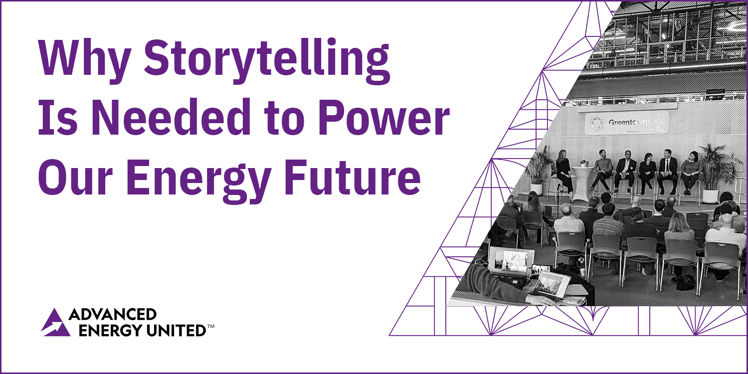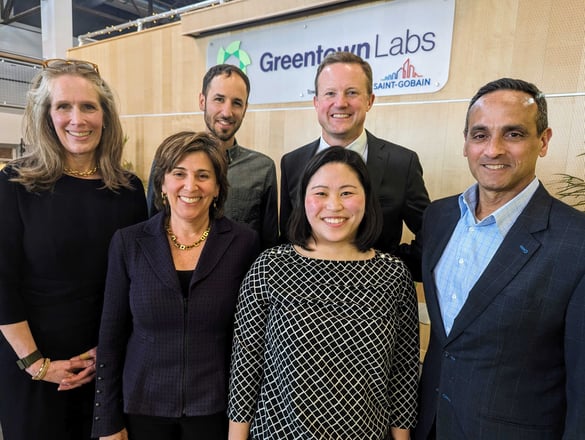
Our industry has a story to tell. It is a great story. It is the story of a growing, job-creating, economic engine of our society. It’s about an industry that is poised to leverage billions of dollars in federal and state funds into many billions more in private investment to transform our energy infrastructure and create the path to a cleaner, more reliable, more affordable energy future. It’s about the chance to bring people who have been ignored or excluded into the energy resource planning process to define and implement community benefit projects that are, in fact, beneficial.
Last week, I was privileged to bring together an incredible panel of guests to talk about a story from a different industry in the hope that it could provide lessons and inform a larger discussion about the nation’s clean energy transition and the need to tell our story. Recorded live at Greentown Labs in Somerville, Massachusetts, the event was inspired by the podcast, The Big Dig, produced and hosted by Ian Coss, about the most expensive highway project in U.S. history — one that, for most of its development, was infamously known as a boondoggle, but ultimately succeeded in ameliorating traffic congestion and improving quality of life in the city.
 Back Row: Laura Bartsch of Advanced Energy United, Ian Coss of PRX Productions, and Jeremy McDiarmid of Advanced Energy United. Front Row: Rebecca Tepper of the Massachusetts Secretary of Energy and Environmental Affairs, Maria Robinson of the U.S. Department of Energy, and Joe Curtatone of Northeast Clean Energy Council (NECEC).
Back Row: Laura Bartsch of Advanced Energy United, Ian Coss of PRX Productions, and Jeremy McDiarmid of Advanced Energy United. Front Row: Rebecca Tepper of the Massachusetts Secretary of Energy and Environmental Affairs, Maria Robinson of the U.S. Department of Energy, and Joe Curtatone of Northeast Clean Energy Council (NECEC).
"The ultimate sort of cautionary tale from the Big Dig is that a project can be transformative and at the same time viewed very negatively for a long period of time,” said Ian Coss of PRX Productions in our opening conversation at the event. Coss added, if we are going to succeed at building ambitious projects, “we’re going to have to do better.”
In particular, Coss pointed to the importance of storytelling.
"When I look back at the story of the Big Dig, the kind of overarching lesson... is how important narrative is to public works,” said Coss. “That the way we talk about projects is every bit as important as the way we design them and contract them and fund them.”
Of course, this lesson doesn’t just apply to transportation projects, but any infrastructure project, very much including clean energy infrastructure.
Coss and I were joined on stage by Massachusetts Secretary of Energy and Environmental Affairs Rebecca Tepper, Director Maria Robinson of the U.S. Department of Energy, Northeast Clean Energy Council (NECEC) President Joe Curtatone, and Managing Director and General Counsel Jeremy McDiarmid of Advanced Energy United. The entire panel expressed an appreciation for the importance of storytelling with the public when undergoing any major project with community impact. Two things appear to be true: creating an economy that runs on clean electricity will require us to build large-scale infrastructure projects, and yet people seem pessimistic about our ability to build big even though we’re already doing it.
Highlight reel from the event. To access the full recording, visit here.
"It's not just that it's possible to do big infrastructure, it's that we're doing it already,” said Robinson, whose Grid Deployment Office at U.S. DOE is overseeing several initiatives to bring communities together to develop a bigger, better electric grid with new transmission lines. “This is stuff that we're already doing at a different scale and at different levels. And it's just taking it up a notch and making sure that we are now including more people in the conversation.”
“We're not going to be able to meet our climate goals or build a clean energy economy without changing the way we do things and building a lot of things,” said Secretary Tepper, who has spent her career in both private and public law working to improve energy laws and regulations in Massachusetts. “We're going to have to build solar, we're going to have to build wind, we're going to have to build substations and transmission lines and distribution lines, and all of that is going to require us to have the hearts and minds.”
How do we capture the hearts and minds of the public? We need to be telling a bigger picture story about the clean energy transition, and the benefits it will deliver, including economic prosperity.
 The panel speaks to the audience at Greentown Labs.
The panel speaks to the audience at Greentown Labs.
“To sort of sew it all together into a narrative,” said McDiarmid, who has spent his career working for the clean energy industry in New England. “It's not just one community, it's not just one state, it‘s a national effort that needs to happen to make sure that we are connecting those dots and celebrating the wins. Telling a big picture story so that the little, you know, unfortunate sort of bumps along the road are just that and aren't going to sink the narrative overall.”
“Dreaming big and building big is something this nation has prided itself on,” said Curtatone, who was Mayor of Somerville for 18 years, including the final years of construction of The Big Dig project. “The existential challenge of climate change is the opportunity to forge and build a third industrial revolution, the green industrial revolution, that creates and offers equitable opportunities for everyone to be involved if we do it right.”
As an example, Secretary Tepper pointed to the success of Vineyard Wind, the first commercial offshore wind farm in the U.S. to begin commercial operations.
“They expected that they were going to have something like 400 jobs, they ended up having 900. Celebrate that, that's a big deal,” said Tepper. “How many people have been trained, how many people now have new careers because of this infrastructure project? And just like, the largeness of it, it’s awe-inspiring when you look at it. And I think getting people involved in sort of thinking about it and celebrating the victories, I think also will help with the narrative.”
Another example shared was the need to build more electric transmission infrastructure. Jeremy McDiarmid pointed to Advanced Energy United’s Transmission Possible campaign as an example of storytelling.
“The whole purpose of that [campaign] is to elevate the conversation and to make these often wonky, often protracted, processes a little more digestible to legislators, to other decision makers, to the public, so that there is this sense of why it matters to me, why it matters to my community,” explained McDiarmid. “If we can explain... this is not about where the electrons come from but it's about making sure that electrons are there to turn on my light, charge my car, and run my factory, we're going to be much better off politically.”
We know that within the bigger narrative of our industry, each clean energy project has its own story. To win hearts and minds, we need to share them. Some projects will provide financial benefits to specific communities, some will make a local grid better able to keep up with growing energy demands, others still will come in to create family-supporting jobs where fossil fuel industry jobs are dwindling. As we look ahead to tell our stories, I want to leave you with this quote from Ian Coss from his podcast, that really inspired me (and our event), and I hope inspires you as we work together to build a clean energy future:
“My interest in this whole story springs from a feeling, a hope, really, that our nation is on the precipice of a new era of infrastructure. And I'm not just thinking about roads and bridges here. I'm thinking about wind turbines, solar farms, transmission lines, battery plants, about making our buildings more efficient and our coastlines more resilient to storms and flooding. If you look at any optimistic scenario for surviving climate change, it involves building stuff on a totally unprecedented scale.” - Ian Coss
Let’s go build.
You can learn more about Transmission Possible, a coalition of partners with Advanced Energy United working to educate, engage, and build support across the U.S. for expanded transmission capacity – which is needed to support a 100% clean energy future – by going to TransmissionPossible.org, where you can access our resource hub and sign up for our newsletter about how to get involved supporting the clean energy transition in your community.
